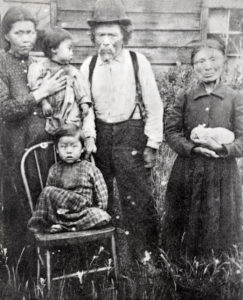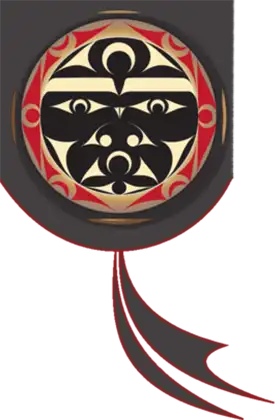sʔadacut Hagan Sam

sʔadacut Edward Hagan Sam
1907-1973
Lushootseed learners at Tulalip are familiar with the photograph of Hagan Sam that they see at the beginning of their first book of Lushootseed stories: he appears as a white-haired elder in a Sunday suit, Bible under his arm, standing by his wife Ethel and posing for a photograph on their way to or from the Shaker Church. Hagan is also one of the first Lushootseed speakers they hear, as he tells on tape the stories transcribed in the present volume. He is a modem man and an ancient man, and it is hard not to think of him as almost two separate beings.1
We wonder what it must have been like to be ‘all at once the descendant of a line of tribal leaders whose known history extends back into the mists of time, a virtuoso of traditional verbal art, a Shaker healer, a logger, a fisherman, a driver of horses across the mountains, a practical joker, a singer of Country Western songs in demand at local fairs and on the radio, and an enthusiastic buyer of new cars. He shares with his generation the mind-altering transition from a life imbued with tradition to a life in which tradition must be sought out.

The photograph of Hagan as a baby gives a sense of the antiquity and importance of his family. A story is told about the encounter between one of his ancestors and a prehistoric water being. The story illustrates how far back the Snohomish presence along this part of the coast extends. One of his ancestors was a hereditary leader of the main Snohomish village in the 1820s or ’30s when the only known tsunami to have occurred in Puget Sound killed large numbers of Snohomish people. Hagan’s grandfather sʔadacut was a traditional healer whose work among the community is talked about even today. His father, Casimir, was a celebrated storyteller, against whose memory our storytellers are still measured. The child sitting in the chair grew up to provide testimony in federal court that helped secure tribal fishing rights and illuminate for succeeding generations the importance of the Killer Whale for the people of Tulalip.
In the work that he did with Thom Hess, Hagan Sam carried on his family’s work of upholding the traditional culture and being of use to the community. The language of his tellings he kept relatively simple for beginners, but in doing so he did not betray the high art of which he was a master. These tellings abound in examples of the narrative strategies that have kept the Lushootseed story community alert and alive through the centuries.
1This introduction combines the memories of William (Sonny) Sam, the late Thom Hess, the late Marya Moses, and the late Hank Gobin.
Some of Hagan Sam’s stories
Mink and Tetyika
Bear and Ant
Coyote and Big Rock
Bear and Fish Hawk
